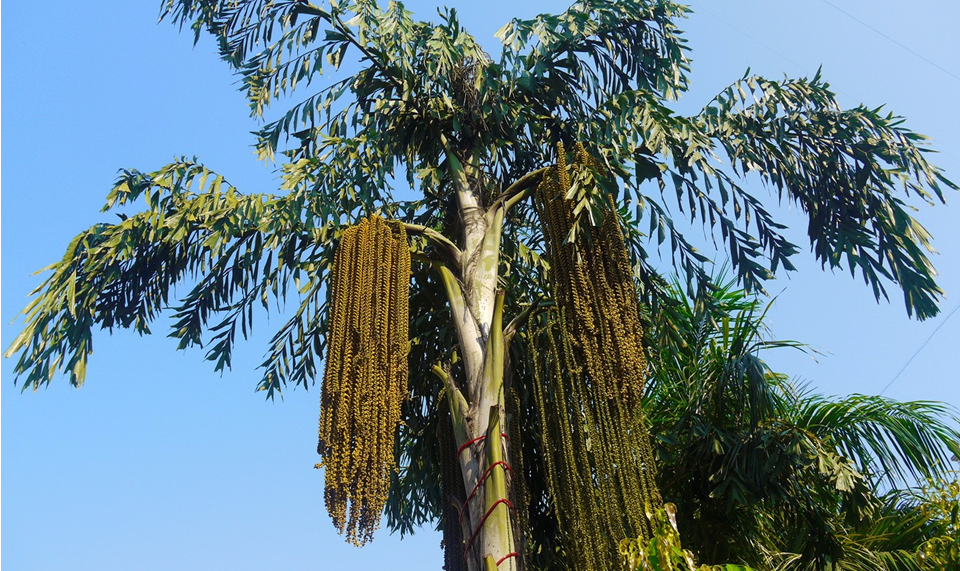
Kitul Treacle and Kitul Products (Caryota urens)
Kitul Treacle
Kitul treacle is made from sap extracted from the inflorescence of the kitul palm, Caryota urens, which grows in Sri Lanka. The treacle is made from pure sap boiled down to a sweet, dark brown syrup, thick and sweet in flavour, with a taste resembling dates with a slight hint of caramel. It is traditionally eaten with curd, a traditional Sri Lankan buffalo yogurt. When the sap is cooked, it also produces a crude sugar called jaggery. Kitul is one of the native sugars of Sri Lanka (cane sugar was not present in the country before colonisation). The treacle of the Caryota urens is often used in baking in addition to serving as a sweetener in food dishes and drinks such as herbal infusions.
Kitul has a much lower calorie content than cane sugar and a high nutritional content: it contains reducing sugars which ensure that the syrup passes through the body rather than being stored. It is a common ingredient in Ayurvedic medicine and a good alternative sweetener for diabetics. Kitul also contains many essential vitamins and minerals including iron, vitamin C, calcium, and phosphorous. When the sap is fresh and left to ferment, kitul sap is the base for traditional vinegar and toddy, a local slightly alcoholic drink. The pith of the Caryota urens is used to make flour, a valuable form of food in Sri Lanka. Many rituals and beliefs are connected with the Caryota urens tree. Some of these practices have contributed to the preservation of this tree species, thus preventing extinction. One such ritual involves leaving the first flower of a Kitul tree in honour of the deities.
This ensures that there will be seeds, and therefore, a new generation of Caryota urens can be grown. For the people of Sri Lanka, tapping the flower to obtain the sap is an art and technique that must be learned. These secret techniques have been handed down from generation to generation throughout the centuries. On an auspicious day, a tapper will begin constructing a bamboo ladder attached to the Kitul tree in order to reach the flower and remove its envelope. The open flower is then left for a few days, after which the tapper returns and cuts the flower from 70 cm to 30 cm; he then ties a thread at the end of the cut inflorescences. A few days later, the tapper applies a mixture of spices on the cut end of the inflorescence, which ensures that the tree will release more sap and therefore more treacle. Not a single part of the Kitul tree goes to waste: the trunk and leaves are used for feeding elephants.
Additionally, once a tree has ceased giving sap and has become senescent (around 12-15 years old), the wood is used for decoration and in many household products. Kitul extraction is a 2000-year old Sri Lankan tradition and the traditional areas of production include the Central Mountains of Sri Lanka, Kotmale area, the villages of Halpola and Kitulgala, the latter named after the tapping of one of the first Kitul trees. The people inhabiting rural Sri Lanka respect the Kitul tree as it provides many gifts from nature in the form of sap, flour, timber, and fibre. Colonisation destroyed much of the country’s natural biodiversity and its rich forest environment. Before colonization and the arrival of cane sugar, Kitul was one of the only sources of natural sugar for Sri Lanka. Furthermore, as a significant part of the land in Sri Lanka was converted into monoculture tea plantations in 1850, a decreased proportion of land was available for the Caryota urens. For some rural communities in Sri Lanka, the sale of Kitul treacle remains the main source of income. Guayapi, a fair trade company that works directly with the traditional sinhalese Forest Garden peoples of moutainous central region in Sri Lanka produces about 5000 litres of Kitul a year, although the sap is also processed and collected by other groups.
Courtesy: www.fondazioneslowfood.com/en/ark-of-taste-slow-food/kitul-treacle/


